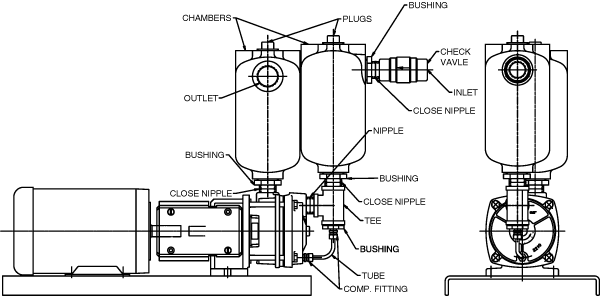Self-Priming Chamber Option

Pumps should not be operated unless they are completely filled with liquid. Damage to parts of the pump that depend on liquid for their lubrication can occur.
Impellers can seize quickly when a pump is run dry. Without lubrication, seal faces can be damaged from heat buildup. Pumps can be easily primed with a vacuum pump. An ejector or liquid ring vacuum pump is recommended because they are not damaged if liquid enters them. Connect the vacuum line to the discharge side of the pump, either in the discharge opening or the drain tap. A foot valve is not necessary when this kind of device is used. When a vacuum pump is not practical, a foot valve in the suction inlet can be used to prevent liquid from running out. The pump and suction line can then be filled completely from an outside source. A vent opening will be necessary during filling to let air escape. A tight foot valve will keep the pump constantly primed so that automatic operation is possible. The valve should be inspected regularly to see that it does not develop leaks, allowing the pump to run dry. Optional self-priming casings are available for MTH pumps allowing priming when a vacuum pump or foot valve is not practical. Refer to specific literature for details.
There are four components to the self primer:
-
A check valve - necessary to maintain a vacuum in the suction line as surging occurs in the pump.
-
An air eliminator - used on the discharge side of the pump to separate air from liquid so the liquid can be used again as air is carried through the pump.
-
A recirculating line - carries liquid from the air eliminator to the suction.
-
A fluid chamber - used on the inlet side to provide a supply of fluid to speed up priming.
Small suction lines are desirable to minimize priming time.
Using the self priming casing, it is only necessary to:
-
Open the plugs in both the inlet and discharge chambers.
-
Pour fluid in one until both are full.
-
Tighten both plugs.
-
Turn on the pump.
Priming time depends on lift, volume of air in the suction line, and the size of the regenerative turbine pump used. If priming time is long and the pump becomes warm, refill the priming chambers with fresh liquid. Most turbine pumps will pump twenty-six to twenty-eight inches of mercury vacuum with cold water in the pump, but have very little capacity and therefore are not practical at lifts over twenty-two feet.
The best way to prime a pump and keep it primed is to use a flooded suction. While this is not always practical, it does provide a number of advantages. The likelihood of pump damage from dry running is eliminated. Suction lines may be large, reducing line losses and minimizing the potential of cavitation damage. There are no check valves or priming devices to fail or require maintenance. Whenever possible, design pumping systems with a flooded suction.






